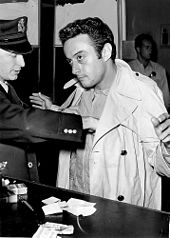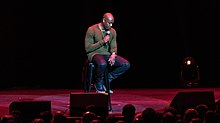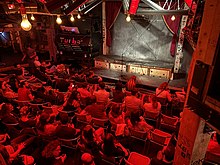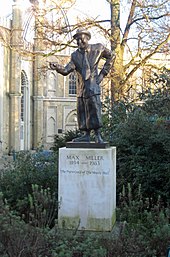Stand-up comedy has roots in various traditions of popular entertainment of the late 19th century, including vaudeville, the stump-speech monologues of minstrel shows, dime museums, concert saloons, freak shows, variety shows, medicine shows, American burlesque, English music halls, circus clown antics, Chautauqua, and humorist monologues like those delivered by Mark Twain in his first (1866) touring show, Our Fellow Savages of the Sandwich Islands.[1][2][3][4][5][6][7] Unadulterated, vaudeville monologuist run-times were 10–15 minutes.[8][9]
Pleasure gardens had outdoor "rooms" with themes.[10] While pleasure gardens hosted shows of minstrelsy and burlesque, the era of American vaudeville can be traced back to 1836, at a pleasure garden called Niblo's Garden, but the term vaudeville wasn't in regular verbal use until the 1840s and didn't commonly appear in writing until the 1890s.[11][12] With the turn of the twentieth century and spread of urban and industrial living, the structure, pacing and timing, and material of American humor began to change.[13][14] Comedians of this era often depended on fast-paced joke delivery, slapstick, outrageous or lewd innuendo, and donned an ethnic persona—African, Scottish, German, Jewish—and built a routine based on popular stereotypes.[15] During the stand-up eras of minstrel, vaudeville, and burlesque, jokes were generally considered to be in the public domain and humorous material was widely shared, appropriated, and stolen.[16] Industrialized American audiences sought entertainment as a way to escape and confront city living. A precursor to stand-up, the era of American burlesque started in the 1860s and ran uncensored until 1937, when the term burlesque could no longer legally be used in New York; burlesque comics used stereotypes and sexually suggestive dialogic humor to appeal to heterosexual men.[7][17][18] The burlesque routine Who's on First? was made famous by Abbott and Costello.
The founders of modern American stand-up comedy include Moms Mabley, Jack Benny, Bob Hope, George Burns, Fred Allen, Milton Berle and Frank Fay, all of whom came from vaudeville or the Chitlin' Circuit.[19][20] They spoke directly to the audience as themselves, in front of the curtain, known as performing "in one". Frank Fay gained acclaim as a "master of ceremonies" at New York's Palace Theater. Vaudevillian Charlie Case (also spelled Charley Case) is often credited with the first form of stand-up comedy, performing humorous monologues without props or costumes. This had not been done before during a vaudeville show.
The 1940s–50s elevated the careers of comedians like Milton Berle and Sid Caesar through radio and television.[21] From the 1930s–50s, the nightclub circuit was owned and operated by the American Mafia.[22][23] Nightclubs and resorts became the breeding ground for a new type of comedian: a stand-up, specifically Lenny Bruce.[24][25] Acts such as Alan King, Danny Thomas, Martin and Lewis, Don Rickles, Joan Rivers and Jack E. Leonard flourished in these venues.

In the 1950s and into the 1960s, "new wave"[26] stand-ups such as Mort Sahl and Lord Buckley began developing their acts in small folk clubs like San Francisco's hungry i (owned by impresario Enrico Banducci and origin of the ubiquitous "brick wall" behind comedians)[27] or New York's Bitter End.[28][29][30] These comedians added an element of social satire and expanded both the language and boundaries of stand-up, venturing into politics, race relations, and sexual humor. Lenny Bruce became known as 'the' obscene comic when he used language that usually led to his arrest.[31] After Lenny Bruce, arrests for obscene language on stage nearly disappeared until George Carlin was arrested on 21 July 1972 at Milwaukee's Summerfest after performing the routine "Seven Words You Can Never Say on Television"[32] Carlin's act was ruled indecent but not obscene, and the Supreme Court granted the FCC permission to censor in a 5–4 ruling from FCC v. Pacifica Foundation.
Other notable comics from this era include Woody Allen, Shelley Berman, Phyllis Diller, and Bob Newhart. Some Black American comedians such as George Kirby, Bill Cosby, Flip Wilson, Godfrey Cambridge, and Dick Gregory began exploring the criticism of "history and myth" in the 1950s–60s, with Redd Foxx testing the boundaries of "uncensored racial humor".[33]
In the 1970s, several entertainers became major stars based on stand-up comedy performances. Richard Pryor and George Carlin followed Lenny Bruce's acerbic style to become icons. Stand-up expanded from clubs, resorts, and coffee houses into major concerts in sports arenas and amphitheaters. Steve Martin and Andy Kaufman were the most popular practitioners of anti-comedy from the 1970s into the 1980s.[34] The older style of stand-up comedy (no social satire) was kept alive by Rodney Dangerfield and Buddy Hackett, who enjoyed revived careers late in life. Don Rickles, whose legendary style of relentless merciless attacks on both fellow performers and audience members alike kept him a fixture on TV and in Vegas from the 1960s all the way to the 2000s, when he appeared in the wildly popular Pixar Toy Story films as Mr. Potato Head, whom Rickles gave his grouchy onstage mannerisms. Television programs such as Saturday Night Live and The Tonight Show helped publicize the careers of other stand-up comedians, including Janeane Garofalo, Bill Maher and Jay Leno.
In the 1980s, Eddie Murphy shaped African American comedy when he created the Black Pack: similar to the Rat Pack, it was a group of stand-up comedians, its members included Paul Mooney, who wrote for Richard Pryor and later starred on Chappelle's Show.[35][36][37][38]
From the 1970s to the '90s, different styles of comedy began to emerge, from the madcap stylings of Robin Williams, to the odd observations of Jerry Seinfeld and Ellen DeGeneres, the ironic musings of Steven Wright, to the mimicry of Whoopi Goldberg and Eddie Murphy. These comedians would serve to influence the next generation of comedians.
Following the height of the 1980s stand-up comedy boom, there was a 1990s comedy bust.[39]
The Aristocrats is a 2005 film based on the original vaudeville joke The Aristocrats, where comedians tell their version of the dirty joke.[40]

Official recognition of present-day stand-up comedians comes from the Mark Twain Prize for American Humor, the New York Friars Club roasts, and The Andy Kaufman Award.[41]
The oldest stand-up comic seems to be Herbert Falk, born May 30, 1921,[42] who performed at the Laughing Skull Comedy club in Atlanta when he was 99 yrs old on Jan 23, 2020. He later performed at the Helium Club in Buffalo, New York, on December 8, 2021 at 100 yrs old. His laughing skull routine can be viewed here . By stroke of fortune, he skirted death in WWII, volunteering to remove land mines under fire,[43] only to be happier delivering stand-up 77 years later. He passed away January 2022 at 100 years old. His obituary can be found here.
Germany
[edit]
Germany developed its stand-up culture in the 1990s, with a growing trend. Among the early pioneers of the later German comedy scene can be counted Loriot, Heinz Erhardt, Otto Waalkes, Dieter Hallervorden or Karl Dall.[citation needed]
Nowadays, many German cities have built their stand-up culture. Berlin currently has the largest comedy scene in Germany, with its own comedy clubs, like Mad Monkey Room [44] since 2017.
Following with Munich, which today has a lot of German and English open mic shows, almost for every day of the week.[45][46]
Britain and Ireland
[edit]
Early twentieth-century front-cloth comics started in music halls, paving the way for stand-up comedy in Great Britain.[47][48][49] Notable front-cloth comics who rose through the variety theatre circuit were Morecambe and Wise, Arthur Askey, Ken Dodd and Max Miller.[50][47] Until 1968, the heavy censorship regime of the Lord Chamberlain's Office required all comedians to submit their acts for censorship. The act would be returned with unacceptable sections underlined in blue pencil (possibly giving rise to the term "blue" for a comedian whose act is considered bawdy or smutty). The comedian was then obliged not to deviate from the act in its edited form.[51]
The rise of the post-war comedians coincided with the rise of television and radio, and the traditional music hall circuit suffered greatly as a result.[citation needed] By the 1970s, music hall entertainment was virtually dead. Alternative circuits had evolved, such as working men's clubs.[51] Some of the more successful comedians on the working men's club circuit—including Bernard Manning, Bobby Thompson, Frank Carson and Stan Boardman—eventually made their way to television via such shows as The Wheeltappers and Shunters Social Club. The "alternative" comedy scene also began to evolve. Some of the earliest successes came from folk clubs, where performers such as Billy Connolly, Mike Harding and Jasper Carrott started as relatively straight musical acts whose between-song banter developed into complete comedy routines. The 1960s had also seen the satire boom, including the creation of the club, the Establishment, which, amongst other things, gave British audiences their first taste of extreme American stand-up comedy from Lenny Bruce.[52] Victoria Wood launched her stand-up career in the early 1980s, which included observational conversation mixed with comedy songs. Wood was to become one of the country's most successful comedians, in 2001 selling out the Royal Albert Hall for 15 nights in a row.[citation needed]
In 1979, the first American-style stand-up comedy club, the Comedy Store was opened in London by Peter Rosengard, where many alternative comedy stars of the 1980s, such as Dawn French and Jennifer Saunders, Alexei Sayle, Craig Ferguson, Rik Mayall and Ade Edmondson began their careers.[53] The stand-up comedy circuit rapidly expanded from London across the UK. The present British stand-up comedy circuit arose from the 'alternative' comedy revolution of the 1980s, with political and observational humor being the prominent styles to flourish. In 1983, young drama teacher Maria Kempinska created Jongleurs Comedy Clubs before it closed in 2017. Stand-up comedy is believed to have been performed originally as a one-man show. Lately, this type of show started to involve a group of young comedians, especially in Europe.[citation needed]







